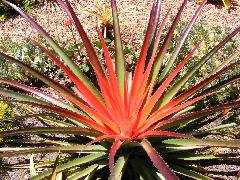
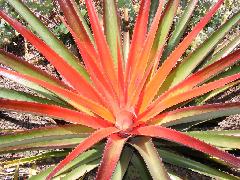
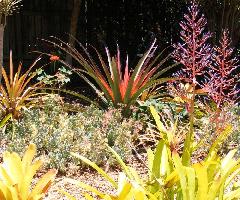
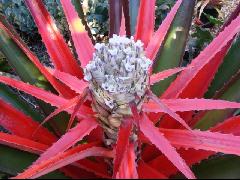
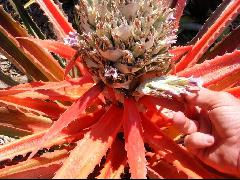

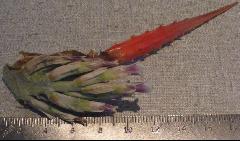
This all started for me in 1982 when I had been seconded by my Employer to work in Sydney for a few months. My Bromelia balansae flowered and it was left to my neighbour to be so astounded at the colours produced that she took photos. The plant got too big and was removed from the front garden and I took little notice of this prickly plant which is a bit slow under Adelaide conditions. Bill Morris did tell me that when he was in Cairns in the 1970’s they had these plants in the centre strip of the main street. I have been advised that these are no more and have been replaced by Pitcairnia of some sort.
In 1995 in the Bromeliad Society Journal page 261, Harry Luther wrote about wrongly named Bromelia in Florida and I felt that the same errors could apply to Australia. Despite my asking people to take photos of their flowering B. balansae I got nowhere. I wasn’t going to grow prickly things like that when I had Tillandsia to play with! Pricklies are best in someone else’s garden and best observed from a distance. Some keen growers in Adelaide maintained that growing the plant in a large plastic pot was the answer but nobody saw a flower with this method but lots of offsets. These invariably emerged through the drainage hole and because it was Harry Bamford’s plant we called it Harry’s Problem because nobody wanted to solve it!
What a surprise when a fellow Tillandsia nutter by the name of Gary May of Brisbane said he had seen this beautifully strikingly red Bromelia balansae growing in someone else’s garden! AND he was prepared to get close and take photos – even to getting access to a single flower so I could check the sepal shape. He even had one in his own backyard that followed closely in flowering too. This is why you see these stunning photos here.
The key to the genus in Smith & Downs is not easy to follow and when you see two or three species names cropping up in more than one place as you wander through the key you realise there is a certain amount of overlapping in key elements! Anyway, I could not get past B. serra, another wide spread species in the wild. Rather tentatively I wrote to Harry Luther for his view and he said, “ I believe you are correct”.
History has a habit of repeating itself and shows how plants that have not had their names changed because nobody read the articles, have a habit of surviving whereas those that have been corrected died. Perhaps we should treat this as Uncle Derek’s Principle or UDP for short. Any way, this is what Mulford Foster wrote over 50 years ago
“NOMENCLATURE CLARIFICATION - No. 6 by Mulford B. Foster in Brom Soc Bull. 5(4): 60. 1955
B. serra versus B. balansae
The most common species of the genus Bromelia in our subtropical gardens is B. balansae. This species was first distributed under the name of B. serra.
B. balansae is native to Argentina, Brasil and Paraguay. It has an upright inflorescence that sometimes reaches four feet. The flowers are borne in a rather tight fitting panicle which branches out as the fruit ripens.
B. serra bears a much smaller and more compact semi-globular flower head and the inflorescence seldom attains more than twelve to eighteen inches in height. Both species are very showy when they are coming into flower, although B. balansae puts on a much more spectacular show with its crimson red bracts which surround the inflorescence.
On the Cover page of The Bromeliad Society Bulletin, Vol. 2, No. 3, May/June 1952, is shown a very good photo of B. pinguin. This species is common throughout the Caribbean and West Indian area, and while there have been some plants of this species in a few gardens, it has not been as popular as B. balansae or the B. serra var. variegata because of its less spectacular color display. Unfortunately, during the past fifteen years or more, practically all of the species in the genus Bromelia to be found in our southern gardens, or in the northern botanical gardens, has been labeled B. pinguin.
The genus in general has been a bit confusing to both botanist and layman but the fresh material of both B. serra and B. balansae the writer collected in 1939 and 1940 helped to clear up some of this confusion. I have collected more than a dozen species of these well-armed spiny members of the genus Bromelia, two of them being new, and I can quite readily understand why so many poor and often incomplete herbarium specimens have been presented to the botanist for identification.”
This raises the question as to whether the variegated Bromelia got to Australia. I feel it did not, otherwise there would be even more fanfare!
So if your B. balansae flowers like the photos then please change its name to B. serra. But please look after it after changing the label – Beware UDP! If it does not agree and you are prepared to do what Gary did, then send me photos too and we will have more investigation.






